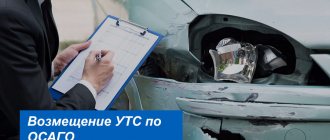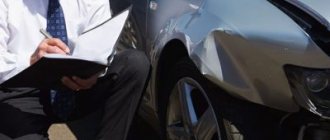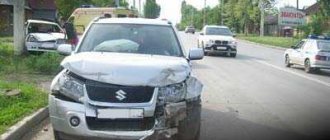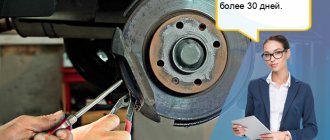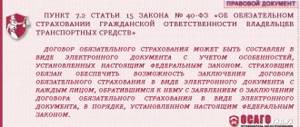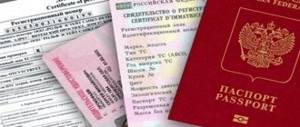Material checked by Expert: Anastasia Tabalina
Experienced lawyer, auto lawyer. Legal assistance in case of deprivation of a driver's license.
Any driver, when selling his car, expects that the price will be as close as possible to the one at which it was purchased. But as a result of an accident, even if high-quality repairs have been made, the value of the car can drop significantly. Therefore, it is so important to make the most accurate calculation of the vehicle’s technical characteristics of the damaged vehicle.
Nuances of calculating vehicle insurance under compulsory motor liability insurance
In order to understand how the vehicle insurance under compulsory motor liability insurance is calculated, you need to know some features. The basis from which the calculation is “based” is the market price of the car. Accordingly, compensation for a luxury car will obviously be higher than for a golf class car. Main parameters taken into account:
- loss of presentation, damage to the coating;
- decrease in performance indicators;
- deterioration of technical strengths. knots caused by repairs.
In order to initiate an examination, certain requirements must be met. Namely:
- If the car is Russian-made, it must be no older than 3 years, if foreign – no older than 5 years.
- Wear - no more than 35%.
- The car gets into an accident for the first time.
- The driver was found not guilty of the accident.
- UTS payments are summed up with insurance ones, and the total amount should not exceed the maximum amount for insurance.
- The MTPL agreement is not expired.
On a note!
Under the CASCO agreement, payments are made on the same terms, unless otherwise stated in the document.
What documents are required?
To obtain a vehicle registration certificate, you must submit some documents. The list includes the following documentation:
- the applicant's civil passport;
- certificate of state registration of the vehicle;
- accident report;
- driver's license to operate a motor vehicle;
- an act that confirms the value of the technical support;
- a document confirming payment for expert services;
- application for compensation for loss of marketable value of a car under compulsory motor liability insurance;
- OSAGO policy.
It is best to develop four sets of documentation copies. One should be sent to the insurance organization, the other should remain with the owner of the vehicle, the third should be sent to another participant in the road incident, and the last should be attached to the lawsuit.
In addition, you must submit an application for reimbursement of the TCB. The compensation procedure has not been formalized by law to date, but there is a general procedure. First, you need to send a pre-trial claim to the insurance company. It should indicate information about the company, indicate information about the citizen, and describe all the details of the incident. The document must indicate the value of the technical specification and provide data from the report of the independent specialist who conducted the examination.
After this, you should submit a request for compensation for lost value. The claim must list documents that are an addition. It must be signed and dated.
UTS calculation methods
Calculation of the loss of marketable value of a car is carried out only by a licensed expert organization. They may use any of the following techniques:
- guidance document;
- Ministry of Justice;
- Halbgevaxa.
Attention!
Before requesting an examination, it is necessary to determine the age of the car and the level of wear. If these parameters exceed legal requirements, this procedure will be meaningless.
Guidance Document Methodology
The most complex and rarely used method of the guidance document is based on calculating the technical resistance for each part damaged in an accident separately. Calculations are carried out using the following formula:
UTS general. = UTS1 + UTS2 + UTS3 + … + UTSπ
Explanation: UTS1 ... UTSπ – the cost of repairing each part separately.
You must first calculate the cost of repairing the part using the following formula:
UTSπ = K x SK x SD
Explanation:
- UTSπ – cost of repair of one element;
- K is an indicator of changes in CTS, it is this that depends on age and wear;
- SC – combined indicator of coefficients;
- SD – retail price of the damaged item.
Example for bumper damage:
| Indicators | Computations | Notes |
| K – 0.4 (according to the coefficient table) SK – 0.030 (removable body part) SD – 1300 rub. | UTSπ = 0.4 x 0.030 x 1300 = 15.6 rubles. | This damage is classified as minor, therefore compensation for the part is small. |
On a note!
Since the technique requires special care and a lot of time, it is applied exclusively to premium cars.
Methodology of the Ministry of Justice
Calculation of TTC in 2021 according to the method of the Ministry of Justice is used much more often than not. It consists of a comparative description of the price of the car before the accident (the cost of a similar car is taken) and after. Formula: NA = C x ∑PC/100
Explanation:
- NA – the difference between the car before the accident and after repair;
- C – the cost of the car before the accident;
- PC – correction factor, available in the expert’s table.
Example of calculation for damage to the upper transverse frame of the radiator:
| Indicators | Computations | Notes |
| C – 1,300,000 rub. PC – 0.1 | NA = 1,300,000 x 0.1/100 = 1,300 rub. | The amount of compensation is insignificant. |
Indicators of correction factors are indicated in expert tables. When installing them, they are guided by the following parameters:
- When performing welding work related to the replacement of components, the correction factor is reduced by 5 times from the initial value.
- Repairing an element cannot be more expensive than replacing them with new ones.
- If the defect is not the result of an accident, I reduce the coefficient by 2.
- Replacing the body paint reduces the final cost of the entire car.
On a note!
If body distortion is detected before an emergency, the coefficient decreases.
Halbgewax technique
Calculation using this method is the most accurate and is used in most cases. The formula resembles the previous one, but has significant clarifications. Namely:
IV = PC/100 x (RS + PCT)
Explanation:
- IV – required data;
- PC – correction factor;
- RS – market value taking into account age and wear and tear;
- PCT – total cost of repair.
When calculating the correction factor, several additional parameters must be taken into account:
- A = PCT/RS x 100%.
- B = OR/CZ x 100%, where OR is payment for the services of craftsmen, CZ is the price of spare parts.
An example of calculating the vehicle vehicle cost of 900,000 and 2 years old:
| Indicators | Computations | Notes |
| RS – 900,000 rub. PCT – 70,000 rub. Central locking – 20,000 rub. Correction factor – 3.5 | OR = 70000 – 20000 = 50000 A = (70000/900000) x 100 = 7.78% B = (50000/20000) x 100 = 250% IV = (3.5/100) x (900000 + 70000) = 33950 | With these calculations, the car owner will receive an amount (IV) of 33,950 rubles. |
It makes sense to carry out calculations when the following parameters are met:
- Value A does not exceed the limits of 10 - 90. If the cost of restoring the car is significantly less than the full cost of the car, then the compensation will be a much smaller amount than conducting an examination with all measurements and calculations.
- Indicator B is more than 40. With these parameters, the cost of work will exceed the price for parts.
On a note!
Calculating the TCB on your own is not an easy task. In order for the figures to have legal force and be presented to the insurance company, the examination must be carried out by a special commission. But you can double-check the data using an online calculator.
What is loss of marketable value of a car under compulsory motor liability insurance?
This term refers to the difference between the value of the car before the accident and after restoration work was carried out to eliminate the damage received after the accident.
Unfortunately, the repairs cannot always be carried out flawlessly and without leaving a trace; visible defects may remain, for example, the color of the paint differs from the main coating, or it will not be possible to completely level out the dent. Or, after restoration, the functional and operational characteristics of the transport have deteriorated. If sold, these factors will affect its value, leading to material damage and loss. The owner of the car can contact the insurance company, which is required by law to pay appropriate compensation for the loss of the commercial value of the car (TCV).
Instructions for receiving compensation
In most cases, when a car owner applies for compensation, insurance companies refuse. But according to the resolution of the Plenum of the Supreme Court No. 58, paragraph 37 of December 26, 2017 “On the application of the law on compulsory motor liability insurance”, a decrease in commodity value is damage and is subject to mandatory compensation under certain conditions. These conditions are enshrined in Art. 7.1 “Research of motor vehicles to determine the cost of restoration repairs and assessment.”
Before starting a legal battle with the insurance company, you must follow these instructions:
- Carry out calculation of the technical equipment. To do this, seek independent expertise from any competent organization that has the appropriate license. Additionally, it is necessary to collect documents confirming the car repair costs incurred, a report from the insurance company on the initial and subsequent inspections.
- After the calculation has been made, the car owner is given a certificate of vehicle registration. It is submitted to the insurance company.
- Employees review the entire package of documents and, if they agree with the presented papers, pay the indicated funds.
- If compensation is refused, the motorist will have to go to court.
Attention!
If, at the time of the occurrence of the insured event, the company with which the MTPL agreement was concluded was declared bankrupt, legal proceedings will begin with the car owner at fault for the accident.
List of required documents
Both when contacting “insurers” and when collecting funds through the court, the most important thing is to fully collect documents. The main package consists of:
- passport;
- driver license;
- a valid MTPL policy;
- vehicle registration certificate (VRC);
- receipt of payment for the examination;
- act with calculations of the expert commission;
- traffic police protocol;
- application from the car owner for compensation.
Attention!
Professional lawyers recommend drawing up at least 4 copies of each document: for the insurance company, for the court, for two participants in the accident.
When collection under UTS is not possible with an MTPL policy
Compensation for damage caused due to the participation of a vehicle in an accident, accident, or force majeure is possible only if all provisions of the insurance contract are observed. Attempts to pay off losses using a car insurance policy are not always successful. Anyone who:
- voluntarily refused to document the fact of an accident, accident, force majeure;
- is the direct culprit of the insured event, as proven by the expert commission;
- is the owner of a vehicle whose operational parameters do not fall within the criteria of the scale for calculating compensation payments under the vehicle transport system;
- I restored the functionality and appearance of the transport components myself, saving on contacting the technical assistance service;
- signed a compulsory motor liability insurance policy, which does not contain a compensation clause for vehicle insurance;
- applies for insurance compensation for the second time.
FAQ
Question
: “The insurance company refused to pay compensation, what should I do next?”
Answer
: “To date, the legislator has not established clear instructions for the collection of TTS, therefore it is necessary to act in accordance with general legal norms:
- pre-trial claim to “insurers”;
- recourse to the court at the location of the insurance company, in case of refusal.”
Question
: “The TTS calculation showed an amount greater than what insurance can cover, from whom should we recover the rest?”
Answer
: “It is necessary to file a claim in court and name the car owner at fault for the accident as the defendant.”
Question
: “Is it possible to pay compensation for a new car if it gets into an accident a second time?”
Answer
: “No, in this case there will be no compensation for damage.”
How to write a statement correctly
This is the first thing the car owner has to do in order to receive compensation. But the application must be drawn up correctly. You must write on the insurance company's letterhead and indicate the requirement to pay compensation for the loss of the car's marketable value.
Also be sure to indicate:
- the place where the incident occurred, the consequence of which was the occurrence of the insured event;
- the reason for the incident;
- your personal data – full name, address of residence, place of work, contact details, etc.;
- car data – make, color, license plate number, and other data.
The application is made in 2 identical copies. Both must be brought to the insurance company and registered with the secretary. He must assign an incoming number to the application, which must be indicated on one of the copies along with the date of acceptance of the document, signature and full name of the secretary. It will be kept by the applicant.
The application must be responded to in writing within 30 days. If it is not there, or it is unsatisfactory, then you can submit documents to the court. The claim must be accompanied by a copy of the application, as well as a copy of the written response.
:
Sample application for vehicle insurance to the insurance company under compulsory motor liability insurance in 2021
Sample application for UTS to insurance under CASCO in 2021
